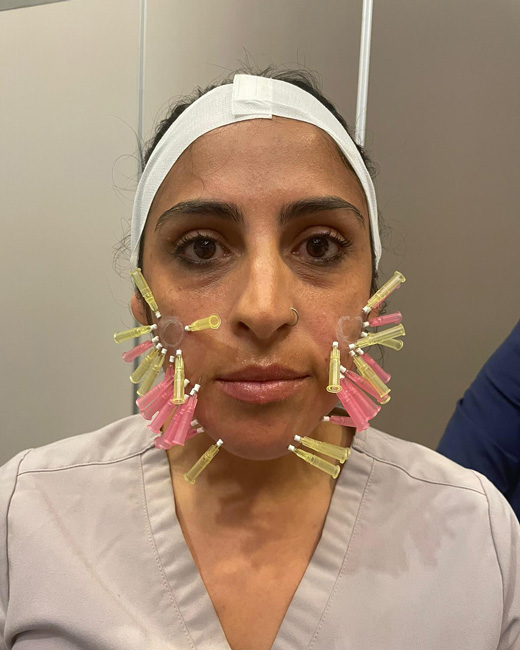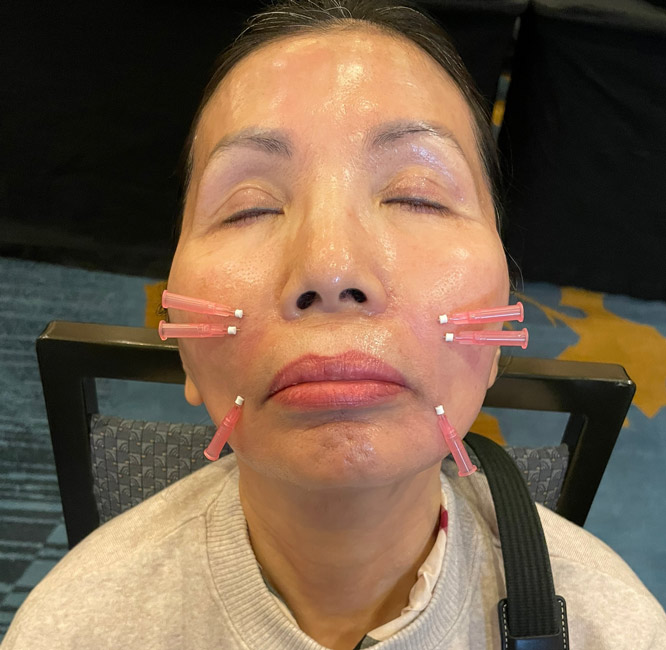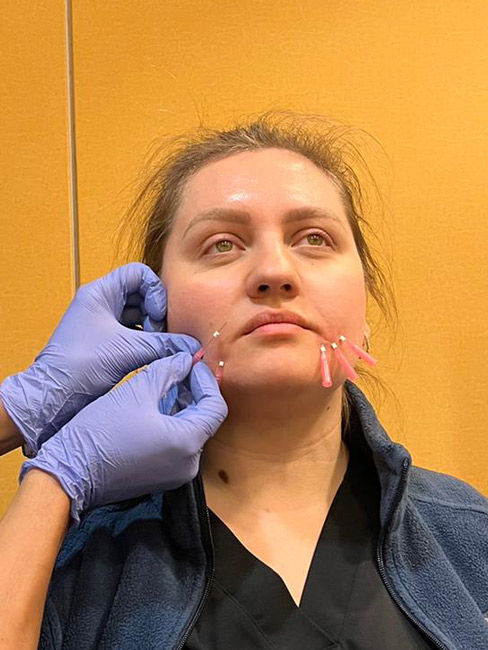Thread Product Specs
Applications
Specialty PDO Cog Thread Sutures
illari Micro F™ uses a blunt cannula (W-Type) for added safety around the eyes or in highly vascularized areas to reduce the risk of edema and bruising. This specialty thread is designed to create collagen remodeling and added support for lateral eye brow lifts and contouring of sensitive areas.
illari Micro F™ reduces the risk of adverse events associated with needle placement and allows for small precision placement of the PDO Threads. A simple 27G needle stick for the injection port is needed for the placement of the 30G thread.
USP Size
Needle Size
Type
Length
6-0
30 Gauge x 25mm
Sharp Needle
35mm
Photos
Watch: Threads in Action
PDO Glossary of Terms
What are PDO threads?
PDO, or polydioxanone, is a biocompatible product commonly used in surgery as an absorbable suture. PDO are not permanent when placed under the skin and will be reabsorbed over about 4 to 8 months. PDO sutures eventually are broken down in the body ultimately ending up as water and carbon dioxide.
There are two (2) basic types of PDO threads – monos (smooth threads) and cogs (barbed sutures).
Monofilament threads (monos or smooth threads) are thin lengths of PDO that are preloaded onto a thin needle which are inserted into the skin. The needle can hold single flat threads, threads wound in a spiral (screw, twisted, tornado) or multiple threads braided together (mesh). The more PDO material in the thread, the more collagenesis is created and biostimulation expected. Mono threads are usually completely absorbed within 4-6 months.
Cog (barbed) threads are thicker lengths of PDO that are loaded onto a cannula which is then inserted into the skin. These threads have little cogs or barbs which will engage the skin and can lift up sagging skin in different areas of the face and body (cheek, jowl, arms, knees, or brow etc.) when the thread is pulled upwards. As they are stronger than mono threads, cogs (barbed threads) can obtain more lifting and contouring. Cog threads are also fully absorbed between 6-9 months.
How do PDO Threads work?
PDO, or polydioxanone, has been shown to stimulate new collagen within the skin. The newer technologies utilizing free floating (no fixation points) PDO Threads allows for much less risk of complications such as scars and nodules that are seen with the older threads that were either permanent or fixed under the skin.
Common treatments such as lasers, peels, RF, or even PRP treatments, cause a wound healing response and a stimulus for new collagen at one point in time. In contrast, PDO threads have an advantage as they can stimulate collagen over a longer period of time (at least 12-18 months).
What can PDO threads do for patients?
A PDO thread lift treatment can help improve skin quality (smooths and rejuvenates), create tissue integrity, and tighten sagging skin on the face, neck and body (arms, abdomen and buttocks). Depending on the indication to be corrected you will use monos (smooth threads), cogs (barbed threads) or combinations of threads.
As a general rule, mono (smooth) threads are suitable for younger patients who are not yet experiencing sagging skin, loss of skin volume, and want to maintain their skin quality. Mono (smooth) threads may help tighten the skin in some areas or to prepare the skin to receive cog threads in the future.
Cog (barbed) threads are generally suitable once there are signs of sagging skin, such as the cheeks or chin area and typically for patients in their 30s onwards. All types of PDO Threads stimulate collagen under the skin where they are placed including the Mono (smooth) or COG (barbed) threads.
Which anatomical areas are most requested by patients concerning thread lift procedures?
The face is the most popular and requested area for treatment. Most patients request lifting around the jawline since the aging process in the face tends to accumulate additional fat around this area and we lose that youthful “V-Shape” to the face. By the age of 40+ the effects of gravity start showing within the face as fat in the cheeks will descend resulting in a flatter, upper part of the face.
Eyebrows are also very popular as well with females as they prefer that the eyebrow be at least 1cm above. Most patients want to fix their eyebrows because they are lower than the desired look. Similarly, as we grow older, it is one of the first noticeable parts of the face that begins to sag and lower. Even as you reach 30+ years of age, your lateral eyebrows will already start to droop and who opt to lift their eyebrows.
Other facial areas for threads include the neck area as well as narrowing the tip of the nose and correct the tip of the nose creating a high nose bridge. It is a 30-minute procedure with zero downtime and very good results.
Which is contraindicated concerning thread lift procedures?
There are both relative and absolute contraindications for the thread lift procedures, though the following illustration may seem like there are many contraindications it is very safe in most of your patients:
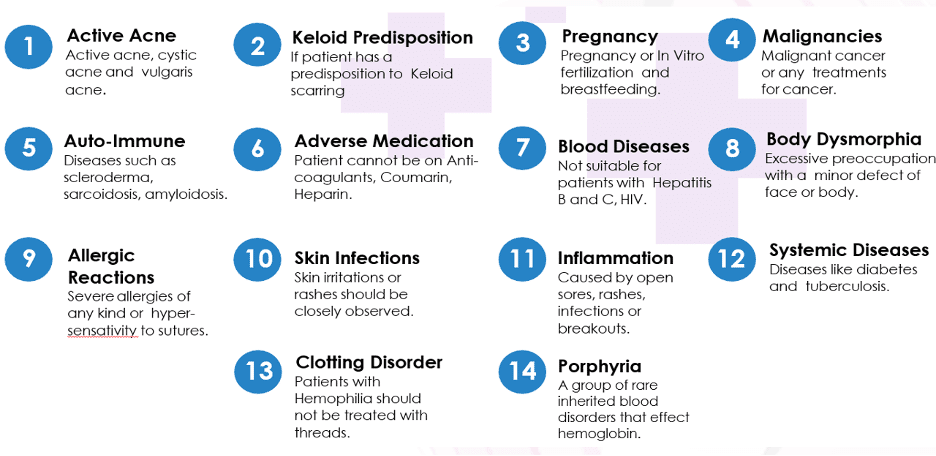
Treatments
Only topical anesthesia is needed for the injection. Bruising in these sensitive areas is drastically reduced though swelling and edema may occur but is different for each patient and treatment indication.
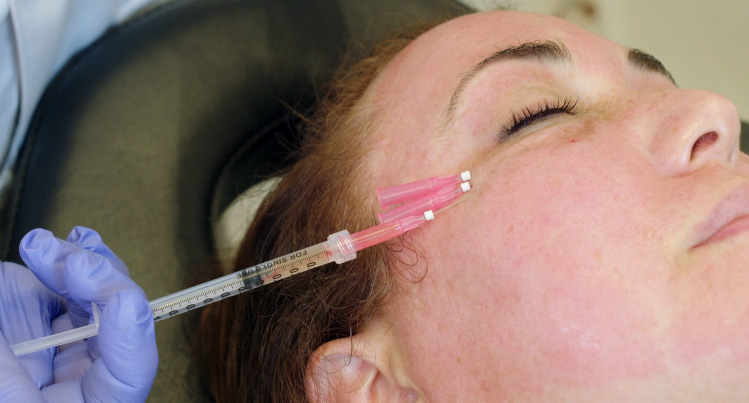


Quality
illari Threads have garnered global acclaim, being trusted and employed by medical professionals all around the world—including Empire Medical Training’s faculty. Our diverse range of threads provide options for practitioners at any level: cutting or molded barbs, multi-braided mesh, embossed—whatever you need to meet your patient’s needs with top-tier quality guaranteed.



